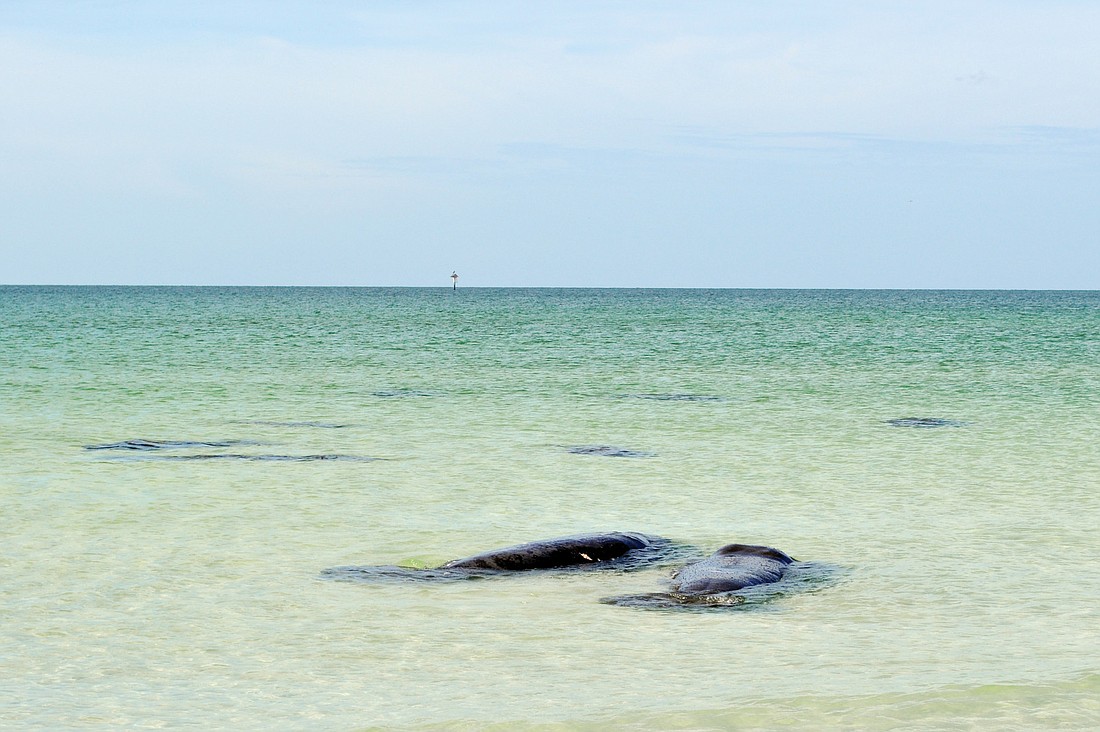- April 19, 2024
-
-
Loading

Loading

When New Jersey resident Mike Czarnecki saw two manatees off of Siesta Key public beach in two feet of seawater last week, he assumed they were dead.
“I thought they were beached carcasses,” Czarnecki said. “I thought the other ones were swimming around to help them — but I guess they’re just having a good time.”
The males in the herd of at least nine manatees pursued at least one female past the sandbar on Siesta beach and into shallow shore near the private beach access for Tivoli by the Sea Resort. The males wanted to mate, and the female(s) were trying to avoid it, said Mote Marine Laboratory senior biologist Sheri Barton, who works in the manatee research program.
“When her (underside) is lying on the bottom, it’s harder for the males to mate with her,” Barton explained in an email. The female can rest on the sandbar and receive fewer passes from suitors, which can’t wriggle to the female’s shallow perch.
In the open water, a group of males can overpower a female. The 1,000-pound marine mammals, which scientists say are a distant relative of the elephant, target estrous females, or those receptive to mating.
Human disturbance can be even more traumatic than male advances, said Mote Marine staff biologist Emma Jugovich, who was monitoring the animals Sept. 14, the morning after they were first spotted.
Jugovich shooed away several onlookers who waded into the water near the manatees to take pictures. Disturbing the endangered marine mammals is illegal, she explained.
Mote Marine works closely with the Florida Fish and Wildlife Conservation Commission to protect manatees and had a rotating crew of staff members, interns and volunteers protecting the herd from human contact, but constant surveillance isn’t possible, and there were several reports of violations.
Mote Marine staff said there were reports of people putting children on the manatees’ backs and attempting to push them into deeper waters. Humans can be seriously injured when manatees buck and thrash about, Mote Marine scientists explained.
The herd was last reported Sept. 18, off Turtle Beach, said Mote Marine Stranding Investigations Program Manager Gretchen Lovewell, but it was gone by the time staff arrived.
To report manatee harassment, call the Florida Wildlife Conservation Coalition Wildlife Alert line at 888-404-3922 or Mote Marine Laboratory Stranding Investigations Program at 988-0212.
RARE VISITOR LANDS ON SIESTA
The mystery of the manatee herd may have been solved quickly, but an uncommon shorebird spotted during the 2012 International Coastal Cleanup, less than 20 feet from the mating marine mammals, is still being discussed in the Sarasota birding community, said Sandy Ulrikson. Ulrikson, along with her husband, Jerry, participated in the coastal cleanup with First United Methodist Church, in Sarasota.
The Ulriksons, who are members of the Sarasota Audubon Society, said during the coastal cleanup they suspected the bird was a Greater Shearwater. After contacting Sarasota Audubon Society President Jeanne Dubi, who investigated the species on Siesta, Ulrikson said in an email it was a Pomarine Jaeger.
“It usually stays two to 50 miles offshore in the open ocean,” Ulrikson said.